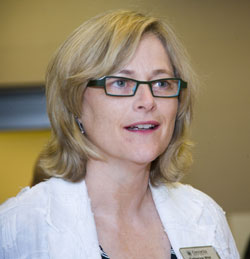Wild: Change and engagement

Dean of Fine Arts Catherine Wild addressed guests last term at the grand opening of the FOFA Gallery on the ground level of the EV Building.
photo by Kate Hutchinson
The Faculty of Fine Arts is reaching out in all sorts of ways — performance and creation, research and influence. Catherine Wild, who has been in the dean’s office for a little more than a year, is enthusiastic about the activity she sees around her.
“One of my biggest pleasures was to see that the faculty are so engaged. They have a strong commitment to their teaching and research. Student involvement is equally strong, highlighted by the tremendous profile of the student-run multi-disciplinary festival Art Matters,” she said in a year-end interview.
Wild’s arrival coincided with the move of several of departments into the eastern tower of the Engineering, Computer Science and Visual Arts Integrated Complex (EV) on Ste. Catherine St.
“Seeing the building fully kitted out was fabulous,” she said. “In October 2005, former dean Christopher Jackson and Don McLean, the head of McGill’s Schulich School of Music, were hosts at a conference of fine arts deans from across Canada. The new EV building created a very positive impression and reinforced the Faculty’s national profile.”
The new space, plus a $15-million grant from the Canada Foundation for Innovation to support Hexagram, an institute for research/creation in media arts, made integrated research and teaching facilities available; in fact, some lab equipment is still being installed.
Hexagram now has about 75 participating artist-researchers, eight research axes, 350 graduate students and the active involvement of all the Montreal universities. It has forged creative relationships between artists and researchers in mathematics, engineering and computer science.
However marvellous, the EV building didn’t completely resolve a longstanding space problem. The faculty, which has approximately 3,000 students, is still scattered across two campuses and more than half a dozen buildings.
Art Education, Art History, Design and Computation Arts and some Studio Arts programs (Fibres, Photography, Print Media and Integrated Media/CyberArts) are in the EV Building.
The rest of Studio Arts (Ceramics, Sculpture, Painting and Drawing), including the MFA in Studio Arts and the Department of Creative Arts Therapies remain in the Visual Arts Building on René-Lévesque Blvd. The Mel Hoppenheim School of Cinema is in the Faubourg Tower, across the street from the EV.
The Music Department is in the old Refectory at Loyola, which is the subject of a renovation effort by Loyola alumni. Contemporary Dance and Theatre are in the TJ annex, a former school off West Broadway.
The Theatre Department is also using Hingston Hall for additional space needs.
The graduate students in Studio Arts have just moved out of the Bourget Building, a former school on de la Montagne St., and the Overdale Building below René-Lévesque Blvd to renovated studios in the VA Building.
The university has announced its intention to move the entire faculty into the huge Grey Nuns Mother House. Former dean Christopher Jackson is heading a fundraising drive to that end, and Wild is cautiously optimistic.
“[The Grey Nuns] has great potential. It’s a site that is meaningful to the larger community beyond the university. It will be a great anchor for Quartier Concordia, enhancing the university’s public presence. Most importantly for the Faculty of Fine Arts, it would bring all of our various parts together, enormously increasing opportunities for research and curricular synergies.
“But [the planning] is challenging. We’re working with an academic space planning firm which has a lot of relevant experience specific to fine arts needs. They are assessing what conditions we need.” After that, the next step will be to see how the conditions of the site fit the Faculty’s needs.
Concordia’s Faculty of Fine Arts has always had a strong reputation in the cultural milieu, Wild said. She sees it as comparable to the Faculty of Fine Arts at York University, in Toronto. “Our program offerings are more diverse than York. We’re a bit larger at the undergrad level, while they currently have more graduate students.
“We’re well known for art history and the visual arts, and in Quebec particularly, for cinema. Cultivating greater awareness of the rich diversity of our programs and the achievements of our students and faculty is a key goal.”
This effort to reach out to the public is already taking form. It includes the new FOFA Gallery in an EV storefront on Ste. Catherine St., the third year of the Defiant Imagination lecture series, housed at the EV as well as the Montreal Museum of Fine Arts, and a celebration of 25 years of contemporary dance planned for March.
Despite the robust health of the faculty she leads, Wild said the postsecondary landscape is changing.
“The early ’90s saw severe economic conditions, but there was also a sharp uptake in enrolment because of the baby boom echo and an increased demand for graduate studies. Changing demographics led to a real renaissance, and increased government interest allowed for more hiring and campus expansion.
“But demographics are shifting again, and the government is changing the formula for how it funds universities,” Wild observed. “We’re in a transitional time, with scarcer resources at hand. It’s likely to be a very challenging few years for all postsecondary institutions. Now is probably a good time to consolidate our strengths, focus on ways to increase our graduate enrolment and enhance our core disciplines.”